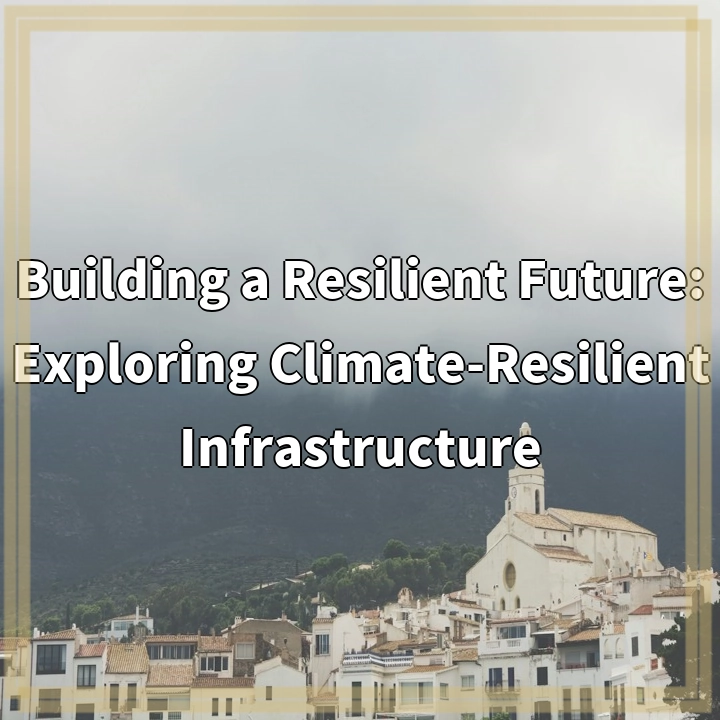
What is Climate-Resilient Infrastructure?
Climate-Resilient Infrastructure refers to the design, construction, and maintenance of infrastructure systems that can withstand and adapt to the impacts of climate change. It involves implementing measures to enhance the resilience of critical infrastructure, such as transportation, energy, water, and communication systems, to the changing climate conditions.
Real-World Problems associated with Climate-Resilient Infrastructure
1. Increasing Frequency and Intensity of Extreme Weather Events: One of the major challenges in building climate-resilient infrastructure is the increasing occurrence of extreme weather events. Floods, storms, heatwaves, and hurricanes are becoming more frequent and intense due to climate change. This poses a significant threat to infrastructure systems, leading to damage, disruption of services, and economic losses.
2. Aging Infrastructure: Another problem is the aging of existing infrastructure. Many countries have outdated infrastructure systems that were not designed to withstand the changing climate conditions. As a result, they are more vulnerable to climate-related impacts. Upgrading and retrofitting such infrastructure to make it resilient can be costly and time-consuming.
3. Limited Funding and Resources: Building climate-resilient infrastructure requires significant financial investments and resources. Unfortunately, many governments and organizations face budget constraints and limited funding, making it challenging to prioritize and implement resilience measures. Lack of resources hinders the development of robust infrastructure systems that can withstand climate-related pressures.
4. Uncertainty in Future Climate Projections: While designing climate-resilient infrastructure, engineers and planners rely on climate projections to anticipate future conditions. However, there is a degree of uncertainty associated with climate models, making it challenging to accurately estimate the level of resilience required. Uncertainty in future climate patterns can impact decision-making and planning processes.
5. Socioeconomic and Equity Considerations: Building climate-resilient infrastructure should also prioritize socioeconomic and equity considerations. Vulnerable communities, low-income areas, and marginalized populations often face disproportionate risks and impacts from climate change. Ensuring equal access to resilient infrastructure and involving local communities in decision-making processes are essential for addressing these challenges.
Conclusion
In an era of escalating climate risks, Climate-Resilient Infrastructure plays a pivotal role in minimizing the vulnerabilities and enhancing the adaptability of our critical systems. However, a range of challenges must be addressed to achieve effective implementation. Overcoming these real-world problems requires collaborative efforts, innovative approaches, and sustained investments. By prioritizing and integrating climate resilience into infrastructure planning and development, we can build a resilient future that can withstand the challenges of a changing climate.

Solutions for Climate-Resilient Infrastructure
There are several solutions that can help address the real-world problems associated with climate-resilient infrastructure. By implementing these measures, we can enhance the resilience of our infrastructure systems and build a more sustainable future.
1. Incorporating Climate Projections and Risk Assessments
To overcome the uncertainty in future climate projections, it is crucial to incorporate the latest climate data and conduct comprehensive risk assessments. This will help engineers and planners make informed decisions regarding the level of resilience required. By utilizing advanced modeling techniques and collaborating with climate scientists, more accurate projections can be made.
2. Upgrading and Retrofitting Existing Infrastructure
The aging infrastructure can be made more resilient by upgrading and retrofitting it to withstand climate-related impacts. This includes reinforcing structures, improving drainage systems, and adopting innovative materials and technologies. Governments and organizations should allocate funds and incentivize the renovation of infrastructure systems to ensure their longevity and adaptability.
3. Enhancing Funding and Financial Mechanisms
To overcome limited funding and resources, governments and international organizations should enhance financial mechanisms for climate-resilient infrastructure projects. This can be done by allocating dedicated funds, exploring public-private partnerships, and leveraging investment from sustainable finance initiatives. Innovative financing solutions, such as green bonds and climate risk insurance, can also provide the necessary capital.
4. Engaging Local Communities and Promoting Equity
Socioeconomic and equity considerations must be at the forefront of climate-resilient infrastructure development. Engaging local communities and vulnerable populations in the decision-making process is essential to ensure that infrastructure projects address their specific needs and challenges. Additionally, policies and regulations should prioritize equal access to resilient infrastructure, reducing the disproportionate impacts on marginalized communities.
5. Integrating Nature-Based Solutions
Nature-based solutions, such as green infrastructure and ecosystem restoration, can play a significant role in enhancing the resilience of infrastructure systems. These approaches utilize natural processes and ecosystems to mitigate the impacts of climate change and increase the adaptability of infrastructure. Examples include creating urban green spaces, protecting and restoring wetlands, and implementing sustainable drainage systems.
Conclusion
By incorporating climate projections, upgrading existing infrastructure, enhancing funding mechanisms, engaging local communities, and integrating nature-based solutions, we can overcome the challenges associated with climate-resilient infrastructure. These solutions, combined with collaborative efforts and an adaptive mindset, will help us build a resilient future that can withstand the impacts of a changing climate.















